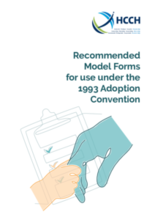The Model Forms are intended to simplify and facilitate compliance with the 1993 Adoption Convention by assisting Contracting Parties in the collection of relevant information. They contain important information regarding safeguards established by the 1993 Adoption Convention, such as the consent of persons, institutions, and authorities in the process of adoption (Art. 4(c) and (d)), the adoptability of the child (Art. 16) and the eligibility and suitability of prospective adoptive parents (Art. 15).
These Model Forms contain important information regarding safeguards established by the 1993 Adoption Convention, such as the consent of persons, institutions, and authorities in the process of adoption (Art. 4(c) and (d)), the adoptability of the child (Art. 16) and the eligibility and suitability of prospective adoptive parents (Art. 15). Thus, the Model Forms are a tool to gather information to ensure that all involved parties can make informed decisions that are in line with the best interests of the child.
For example, the Statement of consent of the child to intercountry adoption form, which has been drafted in a particularly child-friendly style, aligns seamlessly with recognising the right of the child to be heard, having regard to their age and degree of maturity, and have the child be involved in decisions affecting their life — a matter of heightened relevance in today’s intercountry adoption landscape, where adopted children are increasingly of an older age.
The publication of these Recommended Model Forms for use under the 1993 Adoption Convention will serve as another piece in the puzzle towards furthering the protection of children, in complementarity to another recent HCCH publication, the Toolkit for Preventing and Addressing Illicit Practices in Intercountry Adoption.

